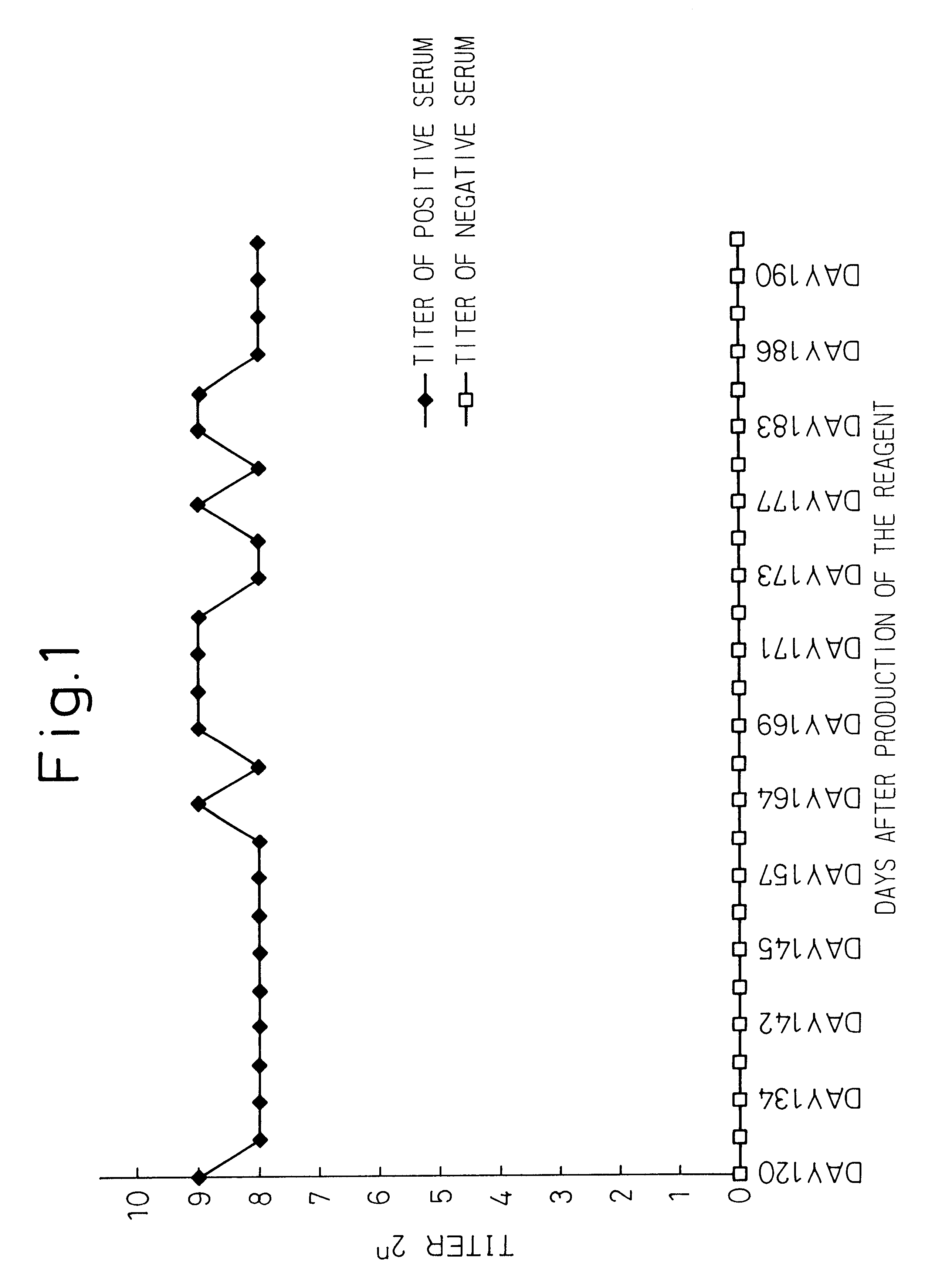Method for detection of human parvovirus and reagent therefor
a parvovirus and reagent technology, applied in the field of human parvovirus b19 detection methods, and reagents therefor, can solve the problems of insufficient sensitivity of conventional methods, long time-consuming and complicated manipulation,
- Summary
- Abstract
- Description
- Claims
- Application Information
AI Technical Summary
Benefits of technology
Problems solved by technology
Method used
Image
Examples
example 1
Preparation of Red Cells
Red cells as a reagent for detecting B19 virus were prepared as follows.
Human O-blood cells with the P-antigen were washed more than three times with 1 / 15M phosphate buffered saline (PBS), pH 7.2. A 10% suspension of the red cells in PBS was fixed with glutaraldehyde at a final concentration of 1%. The fixed cells were washed twice with physiologic saline and once with PBS. The fixed red cells were suspended in PBS at a concentration of 25% and stored at 4.degree. C.
Before the assay, the concentration of the fixed cells was adjusted in the suspension buffer to 1%. The suspension buffer is described as follows.
The suspension buffer consists of 0.1M citrate-phosphate buffer, at pH 5.6, containing 0.1% polyvinylpyrrolidone (PVP-K30), 0.1% arabic gum, 1% sodium chloride, 1% sucrose, and 0.1% sodium aside.
A sample dilution buffer was prepared by adding seronegative human AB serum, at a final concentration of 0.6%, to the suspension buffer.
example 2
We compared this invention, a receptor-mediated hemagglutination (RHA) test, with a PCR test, an ELISA test, and a CIE test on twenty-one B19 virus positive samples.
(1) The Method of the Present Invention
Twenty-five .mu.l of sample diluent buffer was added to a P6 microplate (OLYMPUS) from the first to the eighteenth well. Then we made two-fold serial dilutions of 25 .mu.l of serum up to the eighteenth well. Twenty-five .mu.l of 1% fixed red cell solution was added to each well and mixed together using a microplate mixer for 15 to 30 seconds. After 1 hour at room temperature, the results were obtained.
(2) ELISA
The diluted samples were added to the microwells coated with the IgM antibody specific to the B19 virus. After incubation and a washing procedure, a monoclonal-antibody specific to B19 was added to each well. After a washing step, peroxidase-conjugated anti-mouse IgG was added. Excess conjugate was removed by washing and the bound peroxidase was developed by adding the substra...
example 3
We examined 27,265 samples including B19 positive serum by both methods, RHA and CIE. RHA test was applied to PK7200 (OLYMPUS, automated hemagglutination machine). Seventeen .mu.l of sample serum were mixed with 250 .mu.l of sample diluent buffer. Ten .mu.l of the diluted sample was added, with 40 .mu.l of 0.625% fixed red cells, to a P6 microplate. [Dilution rate; 1 / 39.25] The result of these samples was determined automatically after one hour.
This result indicates table 2.
Twenty-one positive samples in CIE and RHA were also positive in PCR assay. Out of 19 samples, CIE(-) and RHA(+), 6 samples were positive in PCR. This observation suggests that RHA is more sensitive than CIE.
RHA rarely gives a false-positive reaction (13 / 27,265: 0.048%).
PUM
| Property | Measurement | Unit |
|---|---|---|
| pH | aaaaa | aaaaa |
| pH | aaaaa | aaaaa |
| pH | aaaaa | aaaaa |
Abstract
Description
Claims
Application Information
 Login to View More
Login to View More - R&D Engineer
- R&D Manager
- IP Professional
- Industry Leading Data Capabilities
- Powerful AI technology
- Patent DNA Extraction
Browse by: Latest US Patents, China's latest patents, Technical Efficacy Thesaurus, Application Domain, Technology Topic, Popular Technical Reports.
© 2024 PatSnap. All rights reserved.Legal|Privacy policy|Modern Slavery Act Transparency Statement|Sitemap|About US| Contact US: help@patsnap.com








